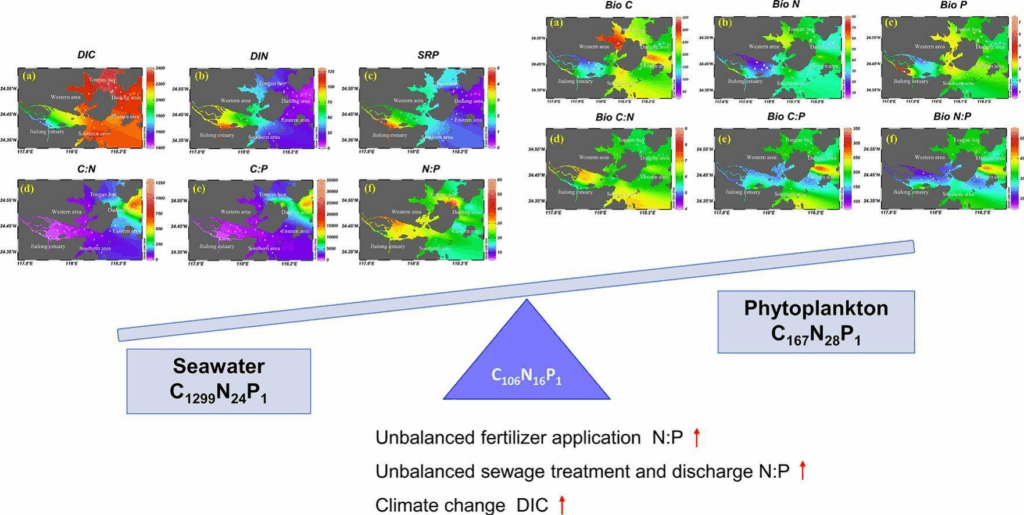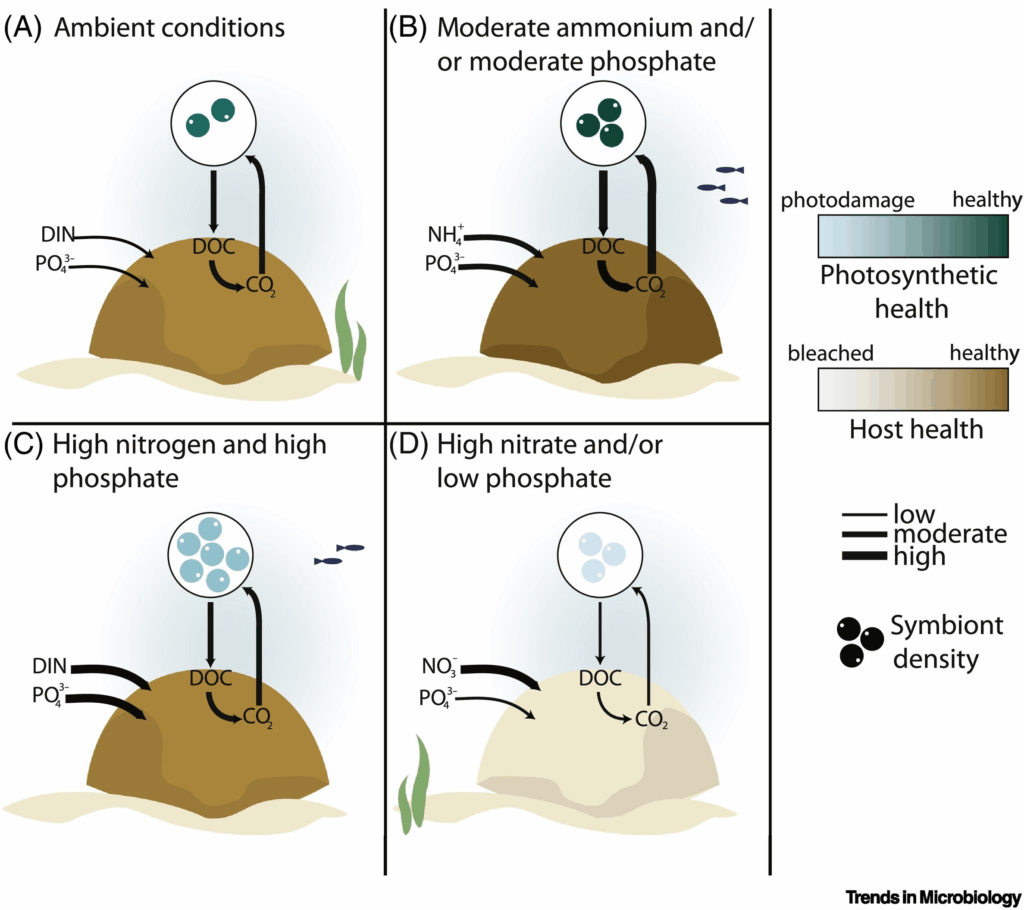
Concept
N:P = a higher N:P ratio
- Increased N = increase in # of zooxanthellae or increase in photosynthesis = increases the need for P
- P limitation = breakdown of photosynthesis
- Carbon taken from calcification process = less carbonate/bicarbonate for calcification = reduced skeletal growth or less dense skeleton.
Result:
- Thin and brittle Skeleton
- Dark Color
- Coral my die
N:P = a low N:P ratio
- Increased P = increase in # of zooxanthellae or increase in photosynthesis = increased need for N.
- Photosynthesis remains efficient.
- Low N levels do not appear to impact coral health as much as low P does.
Result:
- Dark color
- Low impact compare to low po4 and high no3

Tissue Nitrogen(N):Phosporus(P) Ratio Molar Ratio (not nitrate / phospate ratio)
- Coral (animal+bacteria+Zooxanthellae): ~50:1
- Green algae + Dinoflagelattes: ~20:1
- Pythoplankton (Redfield Ratio): 16:1
- Bacteria: 10:1
- Cyanobacteria: 5:1
Ading Carbon Source > 10:1 ratio = Used by Bacteria
Nitrogen(N):Phosporus(P) Ratio
N:P Molar Ratio = No3/Po4*1.53
No3 = 15 mg/L
Po4 = 0.45 mg/L
=(15/0.45)1.53 =33.331.53
=50.99
=N:P 51:1
Example:
No3:Po4 Ratio 90-110
No3 = 5 ppm
Po4 = 0.01 ppm
=5/0.01
=500*1.53
=N:P 765:1 <– Not good
Example:
No3 = 5 ppm
Po4 = 0.01 ppm
=5/0.1
=50*1.53
=N:P 76.5:1 <– good enough
Visualization N:P Ratio

HighNitrate/HighPhospate vs HighNitrate/LowPhospate

Reference N:P Molar ratio In the Sea

An Example Test
- Seabird Island: Good N:P Ratio
- Rat Island: Bad N:P Ratio
- Coral from Seabird put on Seabird: good Grow Rate
- Coral from Rat put on Rat: bad Grow Rate
- Coral from Seabird put on Rat: Bad Grow Rate
- Coral from Rat put on Seabird: Good Grow Rate

Carbonate Alkalinity
- When NO3 is high zooxanthellae use inorganic carbon and outcompete coral for the C needed for calcification.
- Therefore, elevated levels of carbonate alkalinity provide the Disolve-inorganic-Carbon / DIC needed for calcification to continue.
- Can elevated levels of alkalinity prevent coral skeletons from becoming less dense and hence more brittle? Needs to be studied.
- What role might elevated carbonate alkalinity play when the N:P ratio is balanced?
Nutrients – Inorganic Nitrogen – Ammonium
Ammonium NH4+
- Corals will use ammonium as a source of nitrogen if available, so slightly elevated levels in the source water are not detrimental but persistent levels can have several negative effects (next slide).
- Ammonia is less metabolically expensive to use so is preferred.
- Its better to pulse ammonia than to maintain at a set level to lessen any negative effects.
- Greatest benefit when dosing ammonium is seen if bicarbonate is also dosed or alkalinity is at or above NSW values.
Effects of Elevated Ammonium NH4+
- Increased number of zooxanthellae = darker coral.
- Decreased or faster growth rates, the latter producing less dense skeletons.
- Increased resistance to bleaching when thermally stressed!
- Reduced fecundity, fertilization rates and embryo development when high levels (0.02 mg/L) were prolonged.
My Amonium Dosing (DIY) – use your own risk
Dosing Amonia > No3 (NH4)HCO3
- Material Amonium bicarbonate
- Ammonium Bicarbonate NH4 HCO3 sebanyak 20gr campur ke 1000ml RO/DI
- Solution Density Ammonia (mg/L) = 4300
- Density Nitrate (mg/L) = 15700
- Safe Dose Daily (mg/L) = 0.1ppm
- Dose Solutin Daily (mL) /100 Liter = 2.3ml di tank 100L naekin 0.1ppm nh4 / amonia
Inorganic Nitrogen – Nitrate Inorganic Phosphorous aka Orthophosphate
Common Effects of Elevated Nitrate & Phosphate
- Increased number of zooxanthellae = darker coral.
- Decreased or faster growth rates, the latter producing less dense skeletons.
- Increase rate of disease progression e.g. black and white band diseases.
- More susceptible to bleaching when thermally stressed or when light intensity increases e.g. lamp changes.
- Affects vary from species to species.

Reff:
